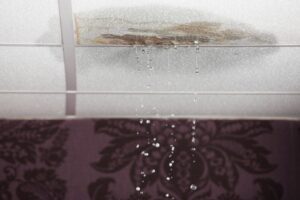When people think of water damage restoration, they often imagine the damage that comes from massive flooding. But water damage is often insidious, spreading without notice until it becomes so extreme it requires extensive restoration.
Since we recently went through several days of heavy downpours in Orange County, we’d like to discuss something related to it: water damage to the ceiling. You may have leaks in your roof that have allowed water from the recent rains to infiltrate into the material of your home’s ceilings. This is a serious problem that needs to be addressed, both with repairs to your roof and with water damage restoration in Orange County, CA. Let’s look at the ways you can detect water damage to your ceiling.
Discoloration and Stains
This is the first sign to look for in your ceiling. After any heavy rainfall, we recommend you look over the ceilings in the highest floor of your home to see if you notice discolored spots. The colors are usually a rusty brown and can take on a number of shapes. You’ll want professional assistance as soon as you see these spots, because water is not only getting in somehow (it may be from plumbing leaks) but it’s already ruining the ceiling material and weakening it. The same might be occurring with the wood in the roofing deck.
Peeling Paint
One of the clear indicators of water damage in a ceiling is the presence of peeling or blistering paint. Water can cause the paint to lose its adhesion to the surface and create visible damage.
Cracks and Bubbles
Water damage often results in the formation of cracks and bubbles on the ceiling. These can appear as small fissures, lines, or raised areas, indicating the presence of moisture that will hurt the structural integrity of the ceiling material.
Sagging or Bulging
Water damage can weaken the structural integrity of the ceiling, causing parts of it to sag or bulge. This distortion is a major indication that water infiltration has compromised the material’s strength and may be pooling or accumulating. Have professionals on the job right away before there’s further collapse and potential safety problems.
Mold or Mildew Growth
The development of mold or mildew on the ceiling is a definite sign of water damage. Both thrive in damp environments, and their presence suggests excessive moisture, which can be detrimental to both the ceiling material and indoor air quality. Mildew eats through drywall quickly, and mold can present health hazards. Mold can start growing fast, in less than 24 hours, so don’t dismiss the possibility just because the rainfall was recent.
Musty Smells or Odors
A musty or damp odor is another telltale sign of water damage—because it’s also a warning of the development of mold and mildew. As water seeps into the ceiling, it creates an environment that encourages mold and mildew, producing distinctive and unpleasant smells.
As with any home restoration project, the faster you move to have professionals on the job, the less damage they’ll have to contend with. When in doubt about water damage to your ceiling, don’t hesitate to contact us.
For comprehensive home restoration services you can rely on, contact Jarvis Restoration today!

